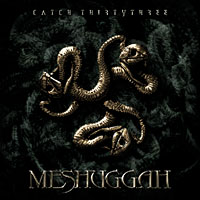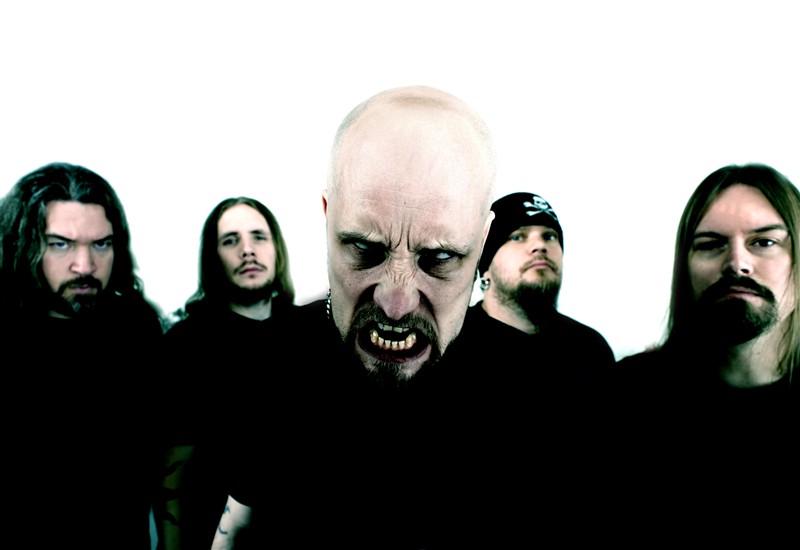
Meshuggah: “Re-Inanimate” (Catch Thirtythree, Nuclear Blast, 5/30/05)
Extreme metal band Meshuggah tends to do exactly what it wants. That attitude has spawned some of the heaviest and most progressive metal of the past two decades. On its 2005 album, Catch Thirtythree, its disregard for convention came in the form of programming software, used to produce all of the drum sounds on a long-form score-style epic. Drummer Tomas Haake and vocalist Jens Kidman explained the process of making the album, and the advantages and stigmas of the “Drumkit from Hell.”
The Drumkit from Hell and the Making of Catch Thirtythree
Tomas: Basically, the Drumkit from Hell is stuff we use on a daily basis whenever we’re writing songs, and the main difference with Catch Thirtythree is that instead of me as the drummer learning the songs, we just kept them programmed on the record. There are a few different reasons for that. Mainly, what we wanted to do with that album — this was an idea that we had for probably 10 years — we wanted to do an experimental piece that was just a one-track full-length album. That album was the first and only album that we’ve written as a band, sitting around the same computer, just trying to improvise and come up with guitar riffs and stuff like that.
At the end of the day, we didn’t really see that album as a live-play album; it was just something that we had been wanting to do. We weren’t even sure that this was going to be an album that we put out, when we started. It was more like, “Let’s do this thing that we’ve wanted to do for a long time.” Pretty early in the process, we liked the stripped-down, more mechanical-sounding drums. Even though they sound like real drums, there’s the occasional fill and such. We dug the idea of how the drums kind of took a step back in the mix, and took a step back as far as not being as much of a main instrument in the band as it has been in some recordings.
Jens: It just fit the process of making that different album really well. It was easy to go in and record part by part. With Tomas playing, we could do everything a lot easier and change stuff instead of having to re-record drums and change stuff. We had everything on the computer; we could just continue on and move parts. Everything was more or less an experiment, and more like a fun thing to do for us.
Tomas: As a drummer, if I was going to be re-recording everything, we’d have to re-record all of the guitar parts. And some of those parts are really, really far out there — kind of just on-the-fly ideas that were immediately recorded as they were. It was more of a random thing.
We felt like if we do this, and then we start rehearsing it, and do a proper album with live drums, we’re going to have to go back and re-record all those guitars. It would have taken away from the initial idea, which is just spur of the moment and lets everything flow freely.
Jens: It was so much easier to just be able to change the song in an early stage. More effective.
Tomas: It was really a trial-and-error kind of project. I don’t know how much time we actually spent on recording those guitars. The project at its peak, before we nailed it down to the 47 minutes that ended up on the album, was something like two-and-a-half hours long. For me to learn all those different parts, it would have just taken forever.
I wish, at some point, that we will play it in its entirety, but it would have to be something that is not a typical live Meshuggah show.
Jens: Maybe a one-off thing for some special event.
Tomas: That would be cool. But we didn’t even write that track. It is just the one track, as we see it, even though there is a whole bunch of different titles on there. They’re just kind of sub-chapters of the whole track. We ended up playing 13 minutes off of that album when we did the touring, but the intention when we wrote it and when we recorded wasn’t so much for live play. It was just one of those things that we wanted to try to do at some point. We ended up deciding, “Okay, let’s do this thing that we’ve been wanting to do for a long time. And screw what everyone says; we’re just gonna do it.”
It’s so funny though, because not using live drums for a band like us is so much of a taboo. That was also one of the reasons why we decided to do it. We know a ton of bands where the drums are programmed, but they will never admit to it. It’s so important to them that people think, “Yeah, you’re playing live.” That was another thing, for me at least, that felt like a release of sorts, just to say, “Yeah, this is programmed,” and just have that out in the open, and then let people decide on whether they think it’s good or not.
A lot of people don’t listen to it; they just immediately think it’s bad because it’s programmed drums. But for us, that’s never been the process. We don’t have that weird pride as musicians. The end product is basically “What am I listening to? Does it sound good to me or does it sound bad? Is this cool or not?” I couldn’t care less if an album was programmed drums, or even if you could program vocals or guitars, I couldn’t care less if you could do that stuff. If it sounds good, it sounds good. At some point, if you’re touring that material, you still have to play it live. That’s when it boils down to “Can you play this or not?”


Y’all are badass first off and its cool to know from my standpoint that you fellas are just musicians without having the ‘badass mentality’. I’ve listened to all of your albums (except ‘RARE TRAX’ & the demo, I don’t know the name of it) and am dieing to see y’all play live. I have much more respect for you fellas knowing that you really don’t give a shit what anyone/band thinks about what you do with your music. And that is cool as hell to admit that ‘Catch ThirtyThree’ drum tracks or the whole album for that matter, is programmed. It must be kind of difficult to play those programmed tracks live. Either way, you guys are MY favorite band of all time….and it should show the metal world that doin’ your own thing is cool to get away with…..maybe one day, when i can afford it, I’ll see you guys perform a live set and maybe even meet ya….much respect fellas, much respect….keep kickn the metal worlds ass! !
Later, Dan Reilly
Win. As always.
At a glance back when it had come out & I bought it freaked me out cuz it was so different than what I was accustomed to in meshuggah songs & formats. Eventually i came to really enjoy it! The drum programming I thought was very cool & it didn’t bother me in the least. I would sit around listening & could never hear anything that even indicated the use of programmed drums. It made me think about some questions which escape me now but thank you very much for this awesome recording guys! Jake_144 http://www.M E S H U G G A H.net
Catch 33 is still the best Meshuggah record as far as I’m concerned. The fact that the drums are programmed does not bother me one bit; the important thing has always been the music. This record really took the doom aspect of Meshuggah to an even more experimental extreme and harmonically is more abstract than anything else in the catalog. The clean-toned section in the second half of In Death is Death is effectively modern classical and well beyond the narrow vision of pretty much every other metal band in existence.
At first when I listened to the album I didn’t realize that the drums were programmed. It was when I opened up the little folder that comes with the record that I noticed that, and it didn’t change my opinion about the album at all.
I was more curious to see how it would turn out live, not that I had any doubts whatsoever that you wouldn’t be able to play it given your excellence on the field of drumming.
Like someone else already said; it was very different but that just broadened the horizon really. And I hold all Meshuggah albums dearly and this is no different. Looking forward to your (hopefully!) next album! Much love from Statoil Råsunda, Sweden!